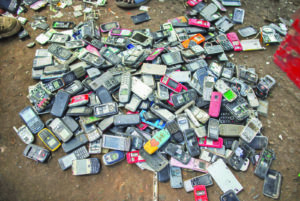How much gold can we get from mobile phones? Leading experts say a tonne of discarded mobile phones is richer in gold than a tonne of gold ore.
On International E-Waste Day 2021 on Thursday, the experts are calling on households, businesses and governments to get behind efforts to get more dead or unused plug-in or battery-operated products to facilities where they can be either repaired or recycled to recover a king’s fortune in valuable materials and reduce the need for new resources.
This year’s mountain of waste electronic and electrical equipment (WEEE) will total about 57.4  million tonnes — greater than the weight of the Great Wall of China, earth’s heaviest artificial object.
million tonnes — greater than the weight of the Great Wall of China, earth’s heaviest artificial object.
Last year’s Global E-waste Monitor reported that 53.6 million metric tonnes (Mt) of WEEE were generated in 2019. That represented a 21 per cent jump in the five years since 2014 (with e-waste predicted to reach 74 Mt by 2030).
Global e-waste generation is growing annually by 2 Mt, or about three to four per cent, a problem attributed to higher consumption rates of electronics (increasing three per cent annually), shorter product lifecycles and limited repair options.
According to estimates in Europe, where the problem is best studied, 11 of 72 electronic items in an average household are no longer in use or are broken. Annually per citizen, another 4 to 5 kg of unused electrical and electronic products are hoarded in Europe prior to being discarded.
Another study estimates that 54 to 113 million mobile phones alone, weighing 10 to 20 tonnes, are sleeping in drawers and other storage spaces in French homes.
Meanwhile in the US, while many mobile phones are recycled, the EPA estimates that more than 151 million phones a year — approximately 416,000 a day — are trashed and end up incinerated or landfilled.
And an estimated 40 per cent of heavy metals in US landfills come from discarded electronics.
By weight, however, discarded big appliances such as stoves and refrigerators constitute the largest component of the e-waste problem, which continues despite decades of efforts by governments at many levels.
The EU, for example, has comprehensive Extended Producer Responsibility (EPR) legislation in place, consisting of targets and legal responsibilities, but member states struggle to achieve them for several reasons, as documented by UNITAR and the Brussels-based WEEE Forum in a report, WEEE Flows study and vision.
Pascal Leroy, Director General of the WEEE Forum, the organisation behind International E-Waste Day, said: “Many factors play a role in making the electrical and electronics sector resource efficient and circular. But one thing stands out: as long as citizens don’t return their used, broken gear, sell it, or donate it, we will need to continue mining all-new materials causing great environmental damage.
“This year’s focus for International E-Waste Day is the crucial role each of us has in making circularity a reality for e-products.”
Surveys reveal a widely-held public misconception that about 40-50 per cent of e-waste is recycled. However, less than half that — 17.4 per cent — was known to be properly treated and recycled in 2019.
In the case of cell phones, tablets, computers and other small information technology products, factors thought to discourage recycling include data security, product value, difficult-to-reach return points, and uncertainty about appropriate recycling, among others.
Says Ruediger Kuehr, Director of the SCYCLE Programme and Head of UNITAR’s Office in Bonn, the value of EEE components in the world’s ‘urban mines’ is enormous.
“A tonne of discarded mobile phones is richer in gold than a tonne of gold ore,” Kuehr points out.
“Embedded in one million cell phones, for example, are 24 kg of gold, 16,000 kg of copper, 350 kg of silver, and 14 kg of palladium — resources that could be recovered and returned to the production cycle.
And if we fail to recycle these materials, new supplies need to be mined, harming the environment.”
“Moreover, the recovery of gold and other material from waste saves a lot of carbon dioxide emissions when compared with virgin metal mining,” says Kees Balde, Senior Programme Officer of the UN University’s SCYCLE Programme.
He adds that high-value, recoverable materials conservatively valued at $57 billion — a sum greater than the Gross Domestic Product of most countries — were mostly dumped or burned in 2019 rather than being collected for treatment and reuse. (IANS)



